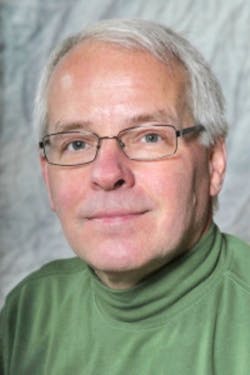At DesignCon, Tektronix’s Byrne links simulation and test
Santa Clara, CA. “Reduce Time to Market with Better Workflow Integration from Simulation to Test” was the title of a DesignCon keynote address delivered Wednesday by Pat Byrne, president, Tektronix, who commented on how to achieve breakthrough innovations in a highly constrained world.
It’s remarkable how innovation is transforming the industry every five or ten years and changing people’s lives for the better, he said. Nevertheless, there are key constraints. Technology is exhibiting an exponential increase in complexity, and—a ramification of significant importance for engineers in the DesignCon community—serial-link time-domain eye diagrams have shrunk to zero margin.
Byrne reviewed the data-rate explosion. In the mid-90s, about when Windows appeared, signal-integrity issues imposed a 50-MHz data-rate barrier. Now we are approaching terahertz.
But the technical challenges aren’t the only issues. Economic complexity plays a role as well, Byrne said. Companies must deliver complex products quickly at cost point that requires only a “single spouse decision”—few hundred dollars.
Byrne then turned his attention to what he called three fundamental variables: energy per bit, dollars per bit, and signal-to-noise ratio, with the last setting limits at the edge of physics, creating a problem that is bumping against market forces.
He then discussed PAM-4 and NRZ, noting that PAM-4 is a complex modulation scheme posing crosstalk problems an order of magnitude greater than other schemes. In contrast, NRZ is less complex and less sensitive to SNR.
Design constraints, he said, require a breakthrough in measurement science, and fundamental sampling approaches need to be rethought. A combination of SNR and bandwidth, he said, noise spectral density drives the ability to make high-performance measurements.
“The underlying measurement science is fundamental,” Byrne said, and a high-performance measurement begins at the business end of the probe. The entire signal path, including mechanics and electronics, begins with getting the probing correct.
Byrne than focused on software-oriented solutions—including meeting the de-embedding challenge. It’s rare you can measure physically what you are interested in, which is most likely invisible to the outside world. Software de-embedding algorithms are a vital part of a measurement system. So, too, is visualization via advanced signal processing.
Taking industry to the next level, Byrne said, will require a combination of simulation technology and measurement technology, and the simulation and measurement markets are about the same size. Go into R&D labs, he said, and you’ll find money spend equally on both sides. The appeal of simulation is the use of predictive modeling to leverage IP. The appeal of measurement is that you don’t ship a simulation—you ship something that works.
Software played a much smaller role 20 or 30 years ago, when engineers would perform a smoke test, which could damage the prototype. “If that happened now,” he said, “the project would be dead.” Subsequently, the two worlds have cohabitated, he said, but with a wall between them and with integration less than optimal. We will need one integrated world moving forward, he said.
He then commented on presilicon and post-silicon points of view. The presilicon phase is led by simulation. An ASIC physical-channel design is done in a simulation environment. Good models can then facilitate electrical verification, characterization, and compliance. What are needed are tools that facilitate sharing across the domains.
“An integrated, expanded workflow is an interesting problem to work on,” he said. Optimally solving the problem will require a common analysis and visualization environment, as well as high-quality measurement science to create the next level of functionality.
He advocated a “shift left” to expand the workflow solution out of the measurement world and into the development phase. That, he said, will facilitate highly parallelized workflows involving highly constrained designs requiring better design margins and the efforts of worldwide teams.
“Collaborate earlier and more deeply,” he advised, adding that solutions are available today.
About the Author

Rick Nelson
Contributing Editor
Rick is currently Contributing Technical Editor. He was Executive Editor for EE in 2011-2018. Previously he served on several publications, including EDN and Vision Systems Design, and has received awards for signed editorials from the American Society of Business Publication Editors. He began as a design engineer at General Electric and Litton Industries and earned a BSEE degree from Penn State.
